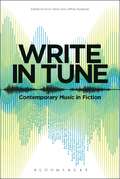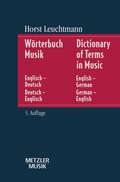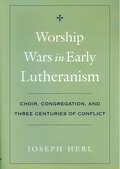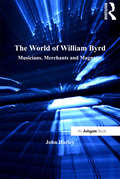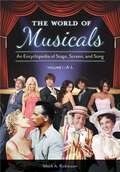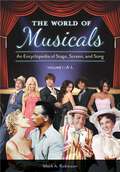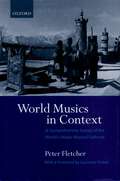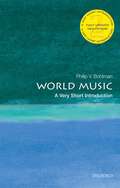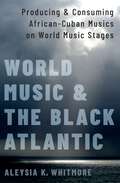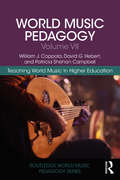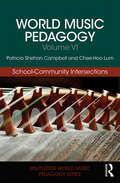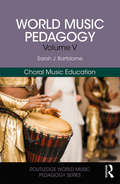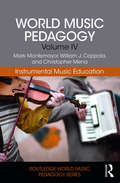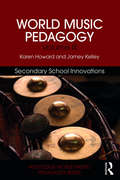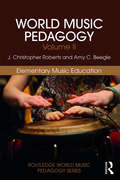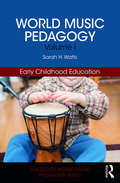- Table View
- List View
Write in Tune: Contemporary Music In Fiction
by Jeffrey Roessner Edited by Erich HertzContemporary popular music provides the soundtrack for a host of recent novels, but little critical attention has been paid to the intersection of these important art forms. Write in Tune addresses this gap by offering the first full-length study of the relationship between recent music and fiction. With essays from an array of international scholars, the collection focuses on how writers weave rock, punk, and jazz into their narratives, both to develop characters and themes and to investigate various fan and celebrity cultures surrounding contemporary music. Write in Tune covers major writers from America and England, including Don DeLillo, Jonathan Franzen, Zadie Smith, and Jim Crace. But it also explores how popular music culture is reflected in postcolonial, Latino, and Australian fiction. Ultimately, the book brings critical awareness to the power of music in shaping contemporary culture, and offers new perspectives on central issues of gender, race, and national identity.
Wörterbuch Musik: Englisch-Deutsch/Deutsch-Englisch. Dictionary of Terms in Music. English-German/German-English
by Horst LeuchtmannDie Neuauflage dieses international als Standardwerk anerkannten Wörterbuchs enthält mehr als 25000 Eintragungen für die deutsche und englische Fachsprache der Musik. Es bietet neben dem historischen und wissenschaftlichen Vokabular auch Begriffe, Ausdrucksweisen sowie Alltagsslang der mit Musik befaßten Fachwelt.
Worship Wars in Early Lutheranism: Choir, Congregation, and Three Centuries of Conflict
by Joseph HerlHow important was music to Martin Luther? Drawing on hundreds of liturgical documents, contemporary accounts of services, books on church music, and other sources, Joseph Herl rewrites the history of music and congregational song in German Lutheran churches. Herl traces the path of music and congregational song in the Lutheran church from the Reformation to 1800, to show how it acquired its reputation as the "singing church." In the centuries after its founding, in a debate that was to have a strong impact on Johann Sebastian Bach and his contemporaries, the Lutheran church was torn over a new style of church music that many found more entertaining than devotional. By the end of the eighteenth century, Lutherans were trying to hold their own against a new secularism, and many members of the clergy favored wholesale revision or even abandonment of the historic liturgy in order to make worship more relevant in contemporary society. Herl paints a vivid picture of these developments, using as a backdrop the gradual transition from a choral to a congregational liturgy. The author eschews the usual analyses of musical repertoire and deals instead with events, people and ideas, drawing readers inside the story and helping them sense what it must have been like to attend a Lutheran church in the sixteenth through eighteenth centuries. Parallel developments in Catholic churches are discussed, as are the rise of organ accompaniment of hymns and questions of musical performance practice. Although written with academic precision, the writing is clear and comprehensible to the nonspecialist, and entertaining anecdotes abound. Appendixes include translations of several important historical documents and a set of tables outlining the Lutheran mass as presented in 172 different liturgical orders. The bibliography includes 400 Lutheran church orders and reports of ecclesiastical visitations read by the author.
Worship Wars in Early Lutheranism: Choir, Congregation, and Three Centuries of Conflict
by Joseph HerlHow important was music to Martin Luther? Drawing on hundreds of liturgical documents, contemporary accounts of services, books on church music, and other sources, Joseph Herl rewrites the history of music and congregational song in German Lutheran churches. Herl traces the path of music and congregational song in the Lutheran church from the Reformation to 1800, to show how it acquired its reputation as the "singing church." In the centuries after its founding, in a debate that was to have a strong impact on Johann Sebastian Bach and his contemporaries, the Lutheran church was torn over a new style of church music that many found more entertaining than devotional. By the end of the eighteenth century, Lutherans were trying to hold their own against a new secularism, and many members of the clergy favored wholesale revision or even abandonment of the historic liturgy in order to make worship more relevant in contemporary society. Herl paints a vivid picture of these developments, using as a backdrop the gradual transition from a choral to a congregational liturgy. The author eschews the usual analyses of musical repertoire and deals instead with events, people and ideas, drawing readers inside the story and helping them sense what it must have been like to attend a Lutheran church in the sixteenth through eighteenth centuries. Parallel developments in Catholic churches are discussed, as are the rise of organ accompaniment of hymns and questions of musical performance practice. Although written with academic precision, the writing is clear and comprehensible to the nonspecialist, and entertaining anecdotes abound. Appendixes include translations of several important historical documents and a set of tables outlining the Lutheran mass as presented in 172 different liturgical orders. The bibliography includes 400 Lutheran church orders and reports of ecclesiastical visitations read by the author.
The World of William Byrd: Musicians, Merchants and Magnates
by John HarleyIn The World of William Byrd John Harley builds on his previous work, William Byrd: Gentleman of the Chapel Royal (Ashgate, 1997), in order to place the composer more clearly in his social context. He provides new information about Byrd's youthful musical training, and reveals how in his adult life his music emerged from a series of overlapping family, business and social networks. These networks and Byrd's navigation within and between them are examined, as are the lives of a number of the individuals comprising them.
The World of William Byrd: Musicians, Merchants and Magnates
by John HarleyIn The World of William Byrd John Harley builds on his previous work, William Byrd: Gentleman of the Chapel Royal (Ashgate, 1997), in order to place the composer more clearly in his social context. He provides new information about Byrd's youthful musical training, and reveals how in his adult life his music emerged from a series of overlapping family, business and social networks. These networks and Byrd's navigation within and between them are examined, as are the lives of a number of the individuals comprising them.
The World of Musicals [2 volumes]: An Encyclopedia of Stage, Screen, and Song [2 volumes]
by Mark A. RobinsonThis wide-ranging, two-volume encyclopedia of musicals old and new will captivate young fans—and prove invaluable to those contemplating staging a musical production.Written with high school students in mind, The World of Musicals: An Encyclopedia of Stage, Screen, and Song encompasses not only Broadway and film musicals, but also made-for-television musicals, a genre that has been largely ignored. The two volumes cover significant musicals in easily accessible entries that offer both useful information and fun facts. Each entry lists the work's writers, composers, directors, choreographers, and cast, and includes a song list, a synopsis, and descriptions of the original production and important revivals or remakes. Biographical entries share the stories of some of the brightest and most celebrated talents in the business.The encyclopedia will undoubtedly ignite and feed student interest in musical theatre. At the same time, it will prove a wonderful resource for teachers or community theatre directors charged with selecting and producing shows. In fact, anyone interested in theatre, film, television, or music will be fascinated by the work's tantalizing bits of historical and theatre trivia.
The World of Musicals [2 volumes]: An Encyclopedia of Stage, Screen, and Song [2 volumes]
by Mark A. RobinsonThis wide-ranging, two-volume encyclopedia of musicals old and new will captivate young fans—and prove invaluable to those contemplating staging a musical production.Written with high school students in mind, The World of Musicals: An Encyclopedia of Stage, Screen, and Song encompasses not only Broadway and film musicals, but also made-for-television musicals, a genre that has been largely ignored. The two volumes cover significant musicals in easily accessible entries that offer both useful information and fun facts. Each entry lists the work's writers, composers, directors, choreographers, and cast, and includes a song list, a synopsis, and descriptions of the original production and important revivals or remakes. Biographical entries share the stories of some of the brightest and most celebrated talents in the business.The encyclopedia will undoubtedly ignite and feed student interest in musical theatre. At the same time, it will prove a wonderful resource for teachers or community theatre directors charged with selecting and producing shows. In fact, anyone interested in theatre, film, television, or music will be fascinated by the work's tantalizing bits of historical and theatre trivia.
World Musics in Context: A Comprehensive Survey of the World's Major Musical Cultures
by Peter FletcherWorld Musics in Context is a wide-ranging survey of musics of the world, in their historical and social contexts, from ancient times to the present day. Ethnomusicologist Peter Fletcher begins by describing aspects of musical style and function in relation to the early developments of civilizations. He then goes on to explore, in five parts, music of the ancient world, music of Africa and Asia, European music, North and South American traditions, and music of the modern world. A compendium of information as well as an examination of musical causation and function, this book gives a deeper understanding of the various musical traditions that contribute to the modern, multicultural environment.
World Music: A Very Short Introduction (Very Short Introductions)
by Philip V. BohlmanThe term 'world music' encompasses both folk and popular music across the globe, as well as the sounds of cultural encounter and diversity, sacred voices raised in worship, local sounds, and universal values. It emerged as an invention of the West from encounters with other cultures, and holds the power to evoke the exotic and give voice to the voiceless. Today, in both sound and material it has a greater presence in human societies than ever before. The politics of which world music are a part - globalization, cosmopolitanism, and nationalism - play an increasingly direct role in societies throughout the world, but are at the same time also becoming increasingly controversial. In this new edition of his Very Short Introduction, Philip Bohlman considers questions of meaning and technology in world music, and responds to the dramatically changing political world in which people produce and listen to world music. He also addresses the different ways in which world music is created, disseminated, and consumed, as the full reach of the internet and technologies that store and spread music through the exchange of data files spark a revolution in the production and availability of world music. Finally, Bohlman revises the way we think of the musician, as an increasingly mobile individual, sometimes because physical borders have fallen away, at other times because they are closing. ABOUT THE SERIES: The Very Short Introductions series from Oxford University Press contains hundreds of titles in almost every subject area. These pocket-sized books are the perfect way to get ahead in a new subject quickly. Our expert authors combine facts, analysis, perspective, new ideas, and enthusiasm to make interesting and challenging topics highly readable.
World Music: A Very Short Introduction (Very Short Introductions)
by Philip V. BohlmanThe term 'world music' encompasses both folk and popular music across the globe, as well as the sounds of cultural encounter and diversity, sacred voices raised in worship, local sounds, and universal values. It emerged as an invention of the West from encounters with other cultures, and holds the power to evoke the exotic and give voice to the voiceless. Today, in both sound and material it has a greater presence in human societies than ever before. The politics of which world music are a part - globalization, cosmopolitanism, and nationalism - play an increasingly direct role in societies throughout the world, but are at the same time also becoming increasingly controversial. In this new edition of his Very Short Introduction, Philip Bohlman considers questions of meaning and technology in world music, and responds to the dramatically changing political world in which people produce and listen to world music. He also addresses the different ways in which world music is created, disseminated, and consumed, as the full reach of the internet and technologies that store and spread music through the exchange of data files spark a revolution in the production and availability of world music. Finally, Bohlman revises the way we think of the musician, as an increasingly mobile individual, sometimes because physical borders have fallen away, at other times because they are closing. ABOUT THE SERIES: The Very Short Introductions series from Oxford University Press contains hundreds of titles in almost every subject area. These pocket-sized books are the perfect way to get ahead in a new subject quickly. Our expert authors combine facts, analysis, perspective, new ideas, and enthusiasm to make interesting and challenging topics highly readable.
WORLD MUSIC & THE BLACK ATLANTIC C: Producing and Consuming African-Cuban Musics on World Music Stages
by Aleysia K. WhitmoreIn the mid-20th century, African musicians took up Cuban music as their own and claimed it as a marker of black Atlantic connections and of cosmopolitanism untethered from European colonial relations. Today, Cuban/African bands popular in Africa in the 1960s and '70s have moved into the world music scene in Europe and North America, and world music producers and musicians have created new West African-Latin American collaborations expressly for this market niche. World Music and the Black Atlantic follows two of these bands, Orchestra Baobab and AfroCubism, and the industry and audiences that surround them-from musicians' homes in West Africa, to performances in Europe and North America, to record label offices in London. World Music and the Black Atlantic examines the intensely transnational experiences of musicians, industry personnel, and audiences as they collaboratively produce, circulate, and consume music in a specific post-colonial era of globalization. Musicians, industry personnel, and audiences work with and push against one another as they engage in personal collaborations imbued with histories of global travel and trade. They move between and combine Cuban and Malian melodies, Norwegian and Senegalese markets, and histories of slavery and independence as they work together to create international commodities. Understanding the unstable and dynamic ways these peoples, musics, markets, and histories intersect elucidates how world music actors assert their places within, and produce knowledge about, global markets, colonial histories, and the black Atlantic. World Music and the Black Atlantic offers a nuanced view of a global industry that is informed and deeply marked by diverse transnational perspectives and histories of transatlantic exchange.
World Music Pedagogy, Volume VII: Teaching World Music in Higher Education (Routledge World Music Pedagogy Series)
by William J. Coppola David G. Hebert Patricia Shehan CampbellWorld Music Pedagogy, Volume VII: Teaching World Music in Higher Education addresses a pedagogical pathway of varied strategies for teaching world music in higher education, offering concrete means for diversifying undergraduate studies through world music culture courses. While the first six volumes in this series have detailed theoretical and applied principles of World Music Pedagogy within K-12 public schools and broader communities, this seventh volume is chiefly concerned with infusing culture-rich musical experiences through world music courses at the tertiary level, presenting a compelling argument for the growing need for such perspectives and approaches.These chapters include discussions of the logical trajectories of the framework into world music courses, through which the authors seek to challenge the status quo of lecture-only academic courses in some college and university music programs. Unique to this series, each of these chapters illustrates practical procedures for incorporating the WMP framework into sample classes. However, this volume (like the rest of the series) is not a prescriptive "recipe book" of lesson plans. Rather, it seeks to enrich the conversation surrounding cultural diversity in music through philosophically-rooted, social justice-conscious, and practice-oriented perspectives.
World Music Pedagogy, Volume VII: Teaching World Music in Higher Education (Routledge World Music Pedagogy Series)
by William J. Coppola David G. Hebert Patricia Shehan CampbellWorld Music Pedagogy, Volume VII: Teaching World Music in Higher Education addresses a pedagogical pathway of varied strategies for teaching world music in higher education, offering concrete means for diversifying undergraduate studies through world music culture courses. While the first six volumes in this series have detailed theoretical and applied principles of World Music Pedagogy within K-12 public schools and broader communities, this seventh volume is chiefly concerned with infusing culture-rich musical experiences through world music courses at the tertiary level, presenting a compelling argument for the growing need for such perspectives and approaches.These chapters include discussions of the logical trajectories of the framework into world music courses, through which the authors seek to challenge the status quo of lecture-only academic courses in some college and university music programs. Unique to this series, each of these chapters illustrates practical procedures for incorporating the WMP framework into sample classes. However, this volume (like the rest of the series) is not a prescriptive "recipe book" of lesson plans. Rather, it seeks to enrich the conversation surrounding cultural diversity in music through philosophically-rooted, social justice-conscious, and practice-oriented perspectives.
World Music Pedagogy, Volume VI: School-Community Intersections (Routledge World Music Pedagogy Series)
by Patricia Shehan Campbell Chee Hoo LumWorld Music Pedagogy, Volume VI: School-Community Intersections provides students with a resource for delving into the meaning of "world music" across a broad array of community contexts and develops the multiple meanings of community relative to teaching and learning music of global and local cultures. It clarifies the critical need for teachers to work in tandem with community musicians and artists in order to bridge the unnecessary gulf that often separates school music from the music of the world beyond school and to consider the potential for genuine collaborations across this gulf. The five-layered features of World Music Pedagogy are specifically addressed in various school-community intersections, with attention to the collaboration of teachers with local community artist-musicians and with community musicians-at-a-distance who are available virtually. The authors acknowledge the multiple routes teachers are taking to enable and encourage music learning in community contexts, such as their work in after-school academies, museums and libraries, eldercare centers, places of worship, parks and recreation centers, and other venues in which adults and children gather to learn music, make music, and become convivial through music This volume suggests that the world’s musical cultures may be found locally, can be tapped virtually, and are important in considerations of music teaching and learning in schools and community contexts. Authors describe working artists and teachers, scenarios, vignettes, and teaching and learning experiences that happen in communities and that embrace the role of community musicians in schools, all of which will be presented with supporting theoretical frameworks.
World Music Pedagogy, Volume VI: School-community Intersections (Routledge World Music Pedagogy Series)
by Patricia Shehan Campbell Chee Hoo LumWorld Music Pedagogy, Volume VI: School-Community Intersections provides students with a resource for delving into the meaning of "world music" across a broad array of community contexts and develops the multiple meanings of community relative to teaching and learning music of global and local cultures. It clarifies the critical need for teachers to work in tandem with community musicians and artists in order to bridge the unnecessary gulf that often separates school music from the music of the world beyond school and to consider the potential for genuine collaborations across this gulf. The five-layered features of World Music Pedagogy are specifically addressed in various school-community intersections, with attention to the collaboration of teachers with local community artist-musicians and with community musicians-at-a-distance who are available virtually. The authors acknowledge the multiple routes teachers are taking to enable and encourage music learning in community contexts, such as their work in after-school academies, museums and libraries, eldercare centers, places of worship, parks and recreation centers, and other venues in which adults and children gather to learn music, make music, and become convivial through music This volume suggests that the world’s musical cultures may be found locally, can be tapped virtually, and are important in considerations of music teaching and learning in schools and community contexts. Authors describe working artists and teachers, scenarios, vignettes, and teaching and learning experiences that happen in communities and that embrace the role of community musicians in schools, all of which will be presented with supporting theoretical frameworks.
World Music Pedagogy, Volume V: Choral Music Education (Routledge World Music Pedagogy Series)
by Sarah J. BartolomeWorld Music Pedagogy, Volume V: Choral Music Education explores specific applications of the World Music Pedagogy process to choral music education in elementary, middle, and high school contexts, as well as within community settings. The text provides clear and accessible information to help choral music educators select, rehearse, and perform a diverse global repertoire. It also guides directors in creating a rich cultural context for learners, emphasizing listening, moving, and playing activities as meaningful music-making experiences. Commentary on quality, commercially available world music repertoire bridges the gap between the philosophy of World Music Pedagogy and the realities of the performance-based choral classroom. All chapters open with a series of vignettes that illuminate the variety of possibilities within multiple K-12 contexts, providing the reader with a sense of how the ideas presented might look "on the ground." Ready-to-integrate activities serve as concrete and pedagogically sound examples to guide directors as they develop their own instructional materials according to the needs of their choir. Content features choral and vocal music-making traditions from South and West Africa; Latin America; Southeast, East, and South Asia; the Pacific Islands; Australia; New Zealand; Scandinavia; and the Baltics.
World Music Pedagogy, Volume V: Choral Music Education (Routledge World Music Pedagogy Series)
by Sarah J. BartolomeWorld Music Pedagogy, Volume V: Choral Music Education explores specific applications of the World Music Pedagogy process to choral music education in elementary, middle, and high school contexts, as well as within community settings. The text provides clear and accessible information to help choral music educators select, rehearse, and perform a diverse global repertoire. It also guides directors in creating a rich cultural context for learners, emphasizing listening, moving, and playing activities as meaningful music-making experiences. Commentary on quality, commercially available world music repertoire bridges the gap between the philosophy of World Music Pedagogy and the realities of the performance-based choral classroom. All chapters open with a series of vignettes that illuminate the variety of possibilities within multiple K-12 contexts, providing the reader with a sense of how the ideas presented might look "on the ground." Ready-to-integrate activities serve as concrete and pedagogically sound examples to guide directors as they develop their own instructional materials according to the needs of their choir. Content features choral and vocal music-making traditions from South and West Africa; Latin America; Southeast, East, and South Asia; the Pacific Islands; Australia; New Zealand; Scandinavia; and the Baltics.
World Music Pedagogy, Volume IV: Instrumental Music Education (Routledge World Music Pedagogy Series)
by Mark Montemayor William Coppola Christopher MenaWorld Music Pedagogy, Volume IV: Instrumental Music Education provides the perspectives and resources to help music educators craft world-inclusive instrumental music programs in their teaching practices. Given that school instrumental music programs—concert bands, symphony orchestras, and related ensembles—have borne musical traditions that broadly reflect Western art music and military bands, instructors are often educated within the European conservatory framework. Yet a culturally diverse and inclusive music pedagogy can enrich, expand, and transform these instrumental music programs to great effect.Drawing from years of experience as practicing music educators and band and orchestra leaders, the authors present a vision characterized by both real-world applicability and a great depth of perspective. Lesson plans, rehearsal strategies, and vignettes from practicing teachers constitute valuable resources. With carefully tuned ears to intellectual currents throughout the broader music education community, World Music Pedagogy, Volume IV provides readers with practical approaches and strategies for creating world-inclusive instrumental music programs.
World Music Pedagogy, Volume IV: Teaching World Music In Higher Education (Routledge World Music Pedagogy Series)
by Mark Montemayor William Coppola Christopher MenaWorld Music Pedagogy, Volume IV: Instrumental Music Education provides the perspectives and resources to help music educators craft world-inclusive instrumental music programs in their teaching practices. Given that school instrumental music programs—concert bands, symphony orchestras, and related ensembles—have borne musical traditions that broadly reflect Western art music and military bands, instructors are often educated within the European conservatory framework. Yet a culturally diverse and inclusive music pedagogy can enrich, expand, and transform these instrumental music programs to great effect.Drawing from years of experience as practicing music educators and band and orchestra leaders, the authors present a vision characterized by both real-world applicability and a great depth of perspective. Lesson plans, rehearsal strategies, and vignettes from practicing teachers constitute valuable resources. With carefully tuned ears to intellectual currents throughout the broader music education community, World Music Pedagogy, Volume IV provides readers with practical approaches and strategies for creating world-inclusive instrumental music programs.
World Music Pedagogy, Volume III: Secondary School Innovations (Routledge World Music Pedagogy Series)
by Karen Howard Jamey KelleyWorld Music Pedagogy, Volume III: Secondary School Innovations provides a rationale and a resource for the implementation of World Music Pedagogy in middle and high school music classes, grades 7–12 (ages 13–18). Such classes include secondary general music, piano, guitar, songwriting, composition/improvisation, popular music, world music, music technology, music production, music history, and music theory courses. This book is not a depository of ready-made lesson plans but rather a tool to help middle and high school teachers to think globally in the music classroom. Strategies and techniques of World Music Pedagogy are promoted by discussions of a multicultural music education, descriptive vignettes of realistic teaching environments, conversations with culture-bearers/pedagogues, and prompts for self-reflection. This volume approaches important issues of multicultural education and social justice that are often neglected in music education texts—proving to be a valuable resource for both nascent music educators and veteran practitioners alike.
World Music Pedagogy, Volume III: Secondary School Innovations (Routledge World Music Pedagogy Series)
by Karen Howard Jamey KelleyWorld Music Pedagogy, Volume III: Secondary School Innovations provides a rationale and a resource for the implementation of World Music Pedagogy in middle and high school music classes, grades 7–12 (ages 13–18). Such classes include secondary general music, piano, guitar, songwriting, composition/improvisation, popular music, world music, music technology, music production, music history, and music theory courses. This book is not a depository of ready-made lesson plans but rather a tool to help middle and high school teachers to think globally in the music classroom. Strategies and techniques of World Music Pedagogy are promoted by discussions of a multicultural music education, descriptive vignettes of realistic teaching environments, conversations with culture-bearers/pedagogues, and prompts for self-reflection. This volume approaches important issues of multicultural education and social justice that are often neglected in music education texts—proving to be a valuable resource for both nascent music educators and veteran practitioners alike.
World Music Pedagogy, Volume II: Elementary Music Education (Routledge World Music Pedagogy Series)
by J. Christopher Roberts Amy C. BeegleWorld Music Pedagogy, Volume II: Elementary Music Education delves into the theory and practices of World Music Pedagogy with children in grades 1-6 (ages 6-12). It specifically addresses how World Music Pedagogy applies to the characteristic learning needs of elementary school children: this stage of a child’s development—when minds are opening up to broader perspectives on the world—presents opportunities to develop meaningful multicultural understanding alongside musical knowledge and skills that can last a lifetime. This book is not simply a collection of case studies but rather one that offers theory and practical ideas for teaching world music to children. Classroom scenarios, along with teaching and learning experiences, are presented within the frame of World Music Pedagogy. Ethnomusicological issues of authenticity, representation, and context are addressed and illustrated, supporting the ultimate goal of helping children better understand their world through music.
World Music Pedagogy, Volume II: Elementary Music Education (Routledge World Music Pedagogy Series)
by J. Christopher Roberts Amy C. BeegleWorld Music Pedagogy, Volume II: Elementary Music Education delves into the theory and practices of World Music Pedagogy with children in grades 1-6 (ages 6-12). It specifically addresses how World Music Pedagogy applies to the characteristic learning needs of elementary school children: this stage of a child’s development—when minds are opening up to broader perspectives on the world—presents opportunities to develop meaningful multicultural understanding alongside musical knowledge and skills that can last a lifetime. This book is not simply a collection of case studies but rather one that offers theory and practical ideas for teaching world music to children. Classroom scenarios, along with teaching and learning experiences, are presented within the frame of World Music Pedagogy. Ethnomusicological issues of authenticity, representation, and context are addressed and illustrated, supporting the ultimate goal of helping children better understand their world through music.
World Music Pedagogy, Volume I: Early Childhood Education (Routledge World Music Pedagogy Series)
by Sarah H. WattsWorld Music Pedagogy, Volume I: Early Childhood Education is a resource for music educators to explore the intersection of early childhood music pedagogy and music in cultural contexts across the world. Focusing on the musical lives of children in preschool, kindergarten, and grade 1 (ages birth to 7 years), this volume provides an overview of age-appropriate world music teaching and learning encounters that include informal versus formal teaching approaches and a selection of musical learning aids and materials. It implements multimodal approaches encompassing singing, listening, movement, storytelling, and instrumental performance. As young children are enculturated into their first family and neighborhood environments, they can also grow into ever-widening concentric circles of cultural communities through child-centered encounters in music and the related arts, which can serve as a vehicle for children to know themselves and others more deeply. Centered around playful engagement and principles of informal instruction, the chapters reveal techniques and strategies for developing a child’s musical and cultural knowledge and skills, with attention to music’s place in the development of young children. This volume explores children’s perspectives and capacities through meaningful (and fun!) engagement with music.
